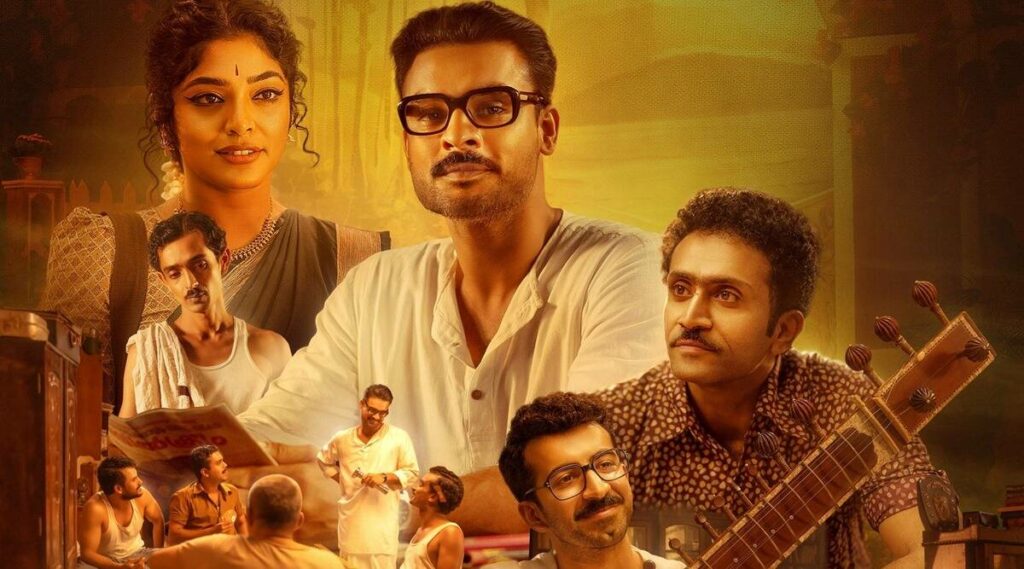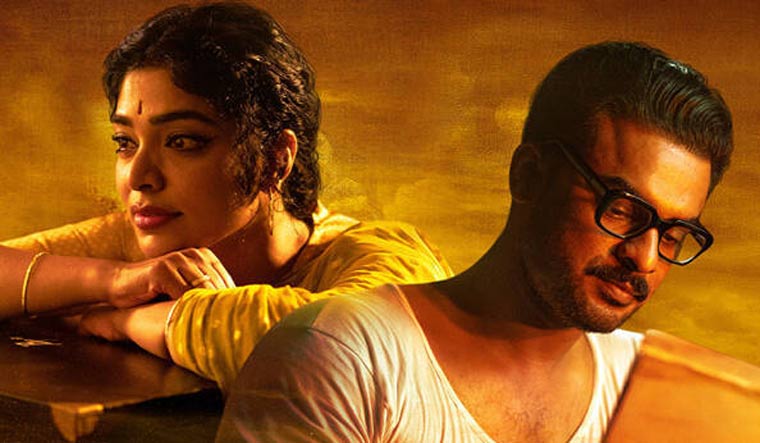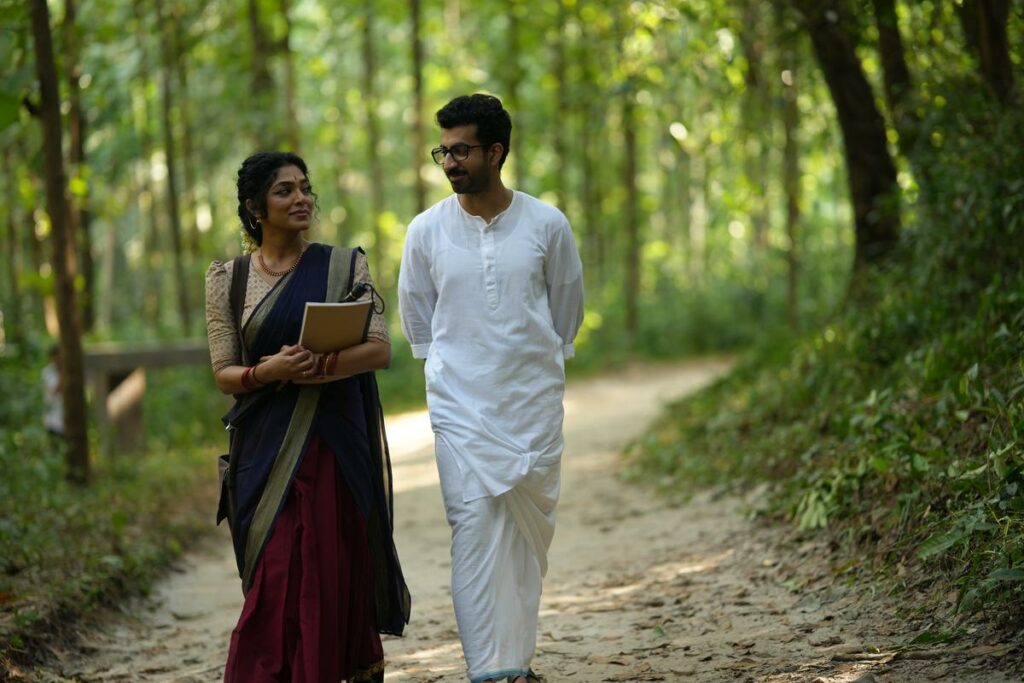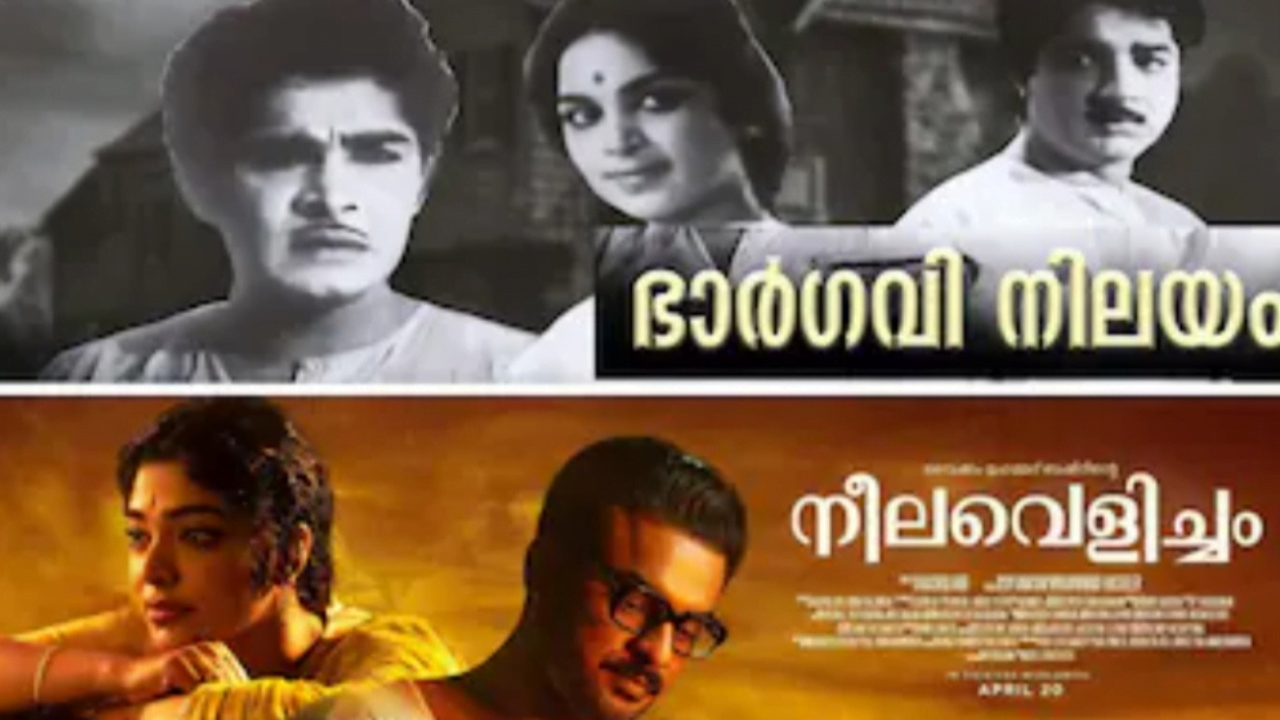Spoiler Alert: This is not a review of the film ‘Neelavelicham’ but it has references to certain scenes and the plot.
Director Aashiq Abu’s new film Neelavelicham (2023) is an adaptation of renowned Malayalam writer Vaikom Muhammad Basheer’s short story Neelavelicham (1952; translated as The Blue Light by V. Abdulla, 1983). It is also simultaneously a remake of an earlier film adaptation of the story by A. Vincent, Kerala’s master storyteller of the silver screen. Bhargavi Nilayam (1964) Vincent’s film adaptation, incidentally, his first feature film, is beloved in the history of Malayalam cinema, as is its famed soundtrack with songs written by the eminent Malayalam lyricist and poet P. Bhaskaran and set to music by the equally acclaimed music director M. S. Baburaj. This is the unavoidable and ineluctable paratextual context of this new film lurking in the minds of all Malayali film viewers.
To be sure, neither Basheer nor Vincent is an easy act to follow, nor is such a comparison fair to a contemporary director who wishes to reimagine this timeless story in a new cinematic idiom. Even so, the sense of dissatisfaction one feels at the end of watching Abu’s Neelavelicham stems not so much from the trappings of unfair sentimental nostalgia, but from a deeper and more troubling and sober regret at how the new retelling misses the main point of the story.
A ghost is not just an entity that haunts a house. A ghost, now dead, was once a living being who died unnaturally with unfinished business in the fullness of life. Thus, haunting is a language, a speech, a reaching out from a vortex of violence in the past to the present. Abu’s new adaptation of the story struggles to deliver this fullness of character for the ghost Bhargavikutty. It also sells short the character of the writer attempting to tell Bhargavikutty’s story.
A ghost is not just an entity that haunts a house. A ghost, now dead, was once a living being who died unnaturally with unfinished business in the fullness of life. Thus, haunting is a language, a speech, a reaching out from a vortex of violence in the past to the present. Abu’s new adaptation of the story struggles to deliver this fullness of character for the ghost Bhargavikutty. It also sells short the character of the writer attempting to tell Bhargavikutty’s story. The result is a feeling of having consumed several wonderful dishes but still feeling hungry.
It is not the fault of the actor Rima Kallingal who plays Bhargavikutty and coproduced the film, nor of Tovino Thomas who plays the writer. They have both performed as well as they could with the material given to them. The shortcoming lies in the screenplay itself which has removed much of the leisurely development of the arc of their love affair, which is integral to understanding them as characters, the intensity of their love story, the violent and misogynist murder, and the subsequent unrest and ghostly haunting.

Bhargavikutty’s murder is an act of femicide, the killing of women, by a rejected man who cannot take “no” for an answer. However, with an attenuated screenplay, the film named after a woman does not really have a lot of screen time for its central female character, either living or dead. It is mostly a male spectacle.
The overall result is that the new film is scenic and spectacular but without the ability to transcend, distinguish, or stand shoulder-to-shoulder with the earlier visualisation of the story and its characters. We don’t necessarily have to remember the older film or its characters, but then the new film is tendentiously set in 1964 as the opening frame tells us, the year Bhargavi Nilayam was released. The new film plays the old film songs. We are not free to watch the new film without remembering the old, just as a haunting always imprisons the present inside the past.
The original short story ends with the writer returning one night to the haunted house to find his room bathed in the titular “blue light.” But Vincent’s film is a leisurely two hours and 45 minutes long unwinding with half of that time fully given over to the past, to the living Bhargavikutty and Sasikumar, and their love story. While the short story ends with the writer, Basheer wrote the arc of Bhargavikutty’s love story specifically for the 1964 film version, an indication that Basheer himself felt the need to develop and flesh out the love story of the ghost and her beloved. The film was not about the writer but about the woman. It is fully a woman’s story. The new retelling is not a woman’s story, in the old sense.
Bhargavi Nilayam Vs Neelavelicham
Basheer’s Bhargavikutty, Vincent’s Bhargavikutty played by the novice actress Vijaya Nirmala in 1964 was no fading wallflower. She falls in love with Sasikumar (played by Prem Nazir) before he falls in love with her. It is instructive that the song that Sasikumar writes for her college function – “Anuraga madhu chashakam” (recreated beautifully in the new film too) – speaks of a butterfly/moth that falls in love with the flame of a lamp even though the heat may singe her wings and scorch her to death, a direct reference to the Persian and Urdu lyric motif of “shama” and “parwana,” the moth that dies in the flames of love and submission. Bhargavikutty is an existential lover.

In 1964, Bhargavikutty is portrayed as “different” from the other characters, more forward, more upfront, more vocal, more assertive, and braver. Bhargavikutty sends her friends packing and even approaches Sasikumar and speaks without coyness draped in wet clothes returning from a dip in the ocean. She repeatedly visits Sasikumar in his house, orders him around, playfully, of course, and conducts a surreptitious love affair across the wall separating their two properties. Her killing is sudden, too sudden. We do not see her reaction at all. The revenge of her ghost rests on the strength of her proud life, and not her pitiable death.
The new Bhargavikutty in Neelavelicham played by Rima Kallingal is somewhat more proper, and she is far more melancholic. Even before she is killed, she has the air of a tragic heroine, which is a far cry from Basheer’s female characters.
The new Bhargavikutty in Neelavelicham played by Rima Kallingal is somewhat more proper, and she is far more melancholic. Even before she is killed, she has the air of a tragic heroine, which is a far cry from Basheer’s female characters.
This is a missed opportunity for Rima Kallingal, a wonderful actress in her own right. She should have had more scenes, happier scenes, and assertive and powerful scenes; Bhargavikutty was an optimist and she and Sasikumar loved each other and did not believe they would be killed. In an act of daring resistance, in the old film, Bhargavikutty sings “Pottaatha Ponnin Kinavu” after Sasikumar has already been killed. “With the unbroken thread of golden dreams/ I spun my silken swing.” The new Bhargavikutty is mostly a tortured and oppressed woman.
Tovino Thomas, another good actor, similarly had some aspects to his characterisation that just did not fit in with Basheer’s writer. For instance, I found it troubling that his character is often shown carrying a dagger. Basheer’s writer does not carry daggers. Pen is mightier than the sword. This to me was the most incongruous and egregious aspect of his characterisation.

In the final fight scene between Sasikumar and Nanukuttan (played by Shine Tom Chacko) in the new film, when Nanukuttan pulls out his dagger, the writer pulls out his dagger as well. Not in Basheer’s world, unfortunately. In the 1964 version, the writer played unforgettably by the great actor Madhu blocks Nanukuttan’s dagger with his rolled-up paper manuscript. That there is Basheer’s writer.
The overall production design of the Neelavelicham is well done; in particular, the night scenes with the looming moon as a motif spread across most of the frames of the film. The “blue light,” or the “blue radiance,” as the title is translated in this new version, could be the ring of blue light around the moon in the night sky as well. Moon, in all cultures, is a symbol of union, of longing for union. In Basheer’s story, the writer plays Bing Crosby’s “Moonlight Becomes You” to Bhargavikutty’s ghost. P. Bhaskaran’s lyrics, shared between the old and the new, connect the separation of lovers to this luminescence of the moon.
Shine Tom Chacko gives a memorable performance in Neelavelicham as the antagonist Nanukuttan and is one definite improvement in the new film in comparison to P. J. Antony’s blackface in the older version. While the almost total deletion of the entire subplot with Kuthiravattam Pappu, the handyman turned dramatist, who churns out pulp stories for the amusement of all, does not create any perceptible gap in the new film, it does remove the self-reflexive element in the older film, a storyteller exploring the world of storytelling. The vivacious brilliance of Basheer the script writer animated the old film. In drastically editing Basheer’s original screenplay, the new film also sacrifices its coherence and charm. The retelling appeared to be in a hurry to be over.

Ultimately, when a dead woman haunts a house, it is always an indictment of what happened to the woman in that house. This is because women and house are metonymically linked, a relationship instinctively acknowledged by Basheer’s writer who remarks ignorantly at the start of his stay in the haunted house that his luck in renting that old mansion is like possessing a beautiful woman that nobody knows about. An ironic statement at best, as Basheer knew. Women and houses both hold secret histories. I am waiting for the next iteration of Basheer’s story where the house literally becomes the woman, the main character.




